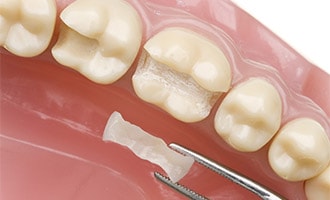
A dental crown is a tooth-shaped cap that is placed over a natural tooth or on top of a dental implant. Crowns cover a tooth down to the gumline, and are generally used to restore a broken-down tooth or replace a missing tooth. They can also be used for cosmetic purposes to change the length, shape or color of a tooth to make it more aesthetic.
As a prosthodontist, Dr. Bhave is a dental specialist in the aesthetic and functional restoration of teeth and the replacement of missing teeth. She is an expert at designing and placing crowns that are durable, aesthetic and function like natural teeth. She makes sure the crown fits comfortably and aligns properly with the rest of your bite.
Benefits of Our Dental Crowns
Dr. Bhave works closely with a high-tech lab that makes crowns out of a variety of high-quality materials and fabricates them according to her exact specifications. She chooses the material for each crown based on what will work best for your situation. Regardless of the materials used, crowns visible in your smile will look aesthetic and will blend well with your other teeth.
For teeth in the front of your smile, she mostly uses a high-quality porcelain that has the translucence of natural teeth. If extra strength is needed, she can use a very durable and aesthetic ceramic that can withstand strong bite forces. Crowns for rear teeth are usually made out of porcelain fused to a metal core. She also provides the option of gold crowns for rear teeth.
Dental Crowns Procedure Details
Dr. Bhave gently removes just enough tooth structure so the crown will fit over it. She then takes an impression of the teeth and bite for the lab to use in fabricating the crown. Dr. Bhave uses the highest quality impression material available to make sure the impression is very accurate and has no distortions.
She creates and places an aesthetic and lifelike temporary crown for you to wear while the permanent crown is being made. Sometimes, she will take an impression of the temporary crown as it sits in your smile for the lab to use in designing the final.
The lab creates the final crown according to Dr. Bhave’s instructions. When your crown comes back from the lab, Dr. Bhave will make any adjustments necessary to ensure it fits comfortably, matches the rest of your teeth and aligns properly in your bite. She will then permanently bond it into place, using the best cement on the market so that the crown will be firmly attached to the tooth.
Inlays and Onlays – “Partial Coverage” Crowns
For damage to a tooth that is too extensive for a filling but does not require a full crown, Dr. Bhave can place “partial coverage” restorations. When the restoration is made to fit in the grooves between the cusps (highest points) of the tooth, it is known as an inlay. A restoration that fits over one or more of the cusps is called an onlay.
Dr. Bhave can fabricate these out of the same high-quality porcelains she uses for full crowns. She also offers the option of making them out of gold. Dr. Bhave will explain the pros and cons of each option to you so that you can make an informed choice.
What Crowns Are Used For?
Crowns are mainly used for the following purposes:
- To protect and repair a damaged or decayed tooth
- To cover and protect a tooth from future fracture after root canal therapy
- To cosmetically correct a discolored or misshapen tooth (in situations where a veneer is not recommended)
- To correct bite misalignment
- To be the replacement tooth that is secured onto a dental implant
Dental Crowns FAQs
What are the benefits of a dental crown?
When teeth are decaying, cracked, chipped, crooked, discolored or in some other way aesthetically compromised, dental crowns are one of the most popular solutions. A crown is a sturdy cover to an existing tooth that not only preserves the functionality of the tooth, but also boosts the quality of its appearance. All flaws disappear beneath the crown, thereby enhancing the attractiveness of your smile.
Crowns are custom made to correspond with the color and size of your other teeth. Typically, a crown will last somewhere between five and 15 years, stabilizing and protecting the integrity of the tooth for that duration. The crown prevents bacteria from entering the tooth, minimizing the risk for future problems. Best of all, crowns are made out of materials that imitate real teeth, so that it both feels normal and does not break down natural teeth when you bite.
What are my choices in dental crowns?
Crowns come in a variety of materials, each with its own advantages. Porcelain crowns are known for being the most durable. Ceramic crowns are most frequently used on front teeth since they are the most difficult to spot, while metal crowns are least likely to cause the opposing teeth to crack, making them best suited for molars. Resin crowns are among the least expensive options, but have a shorter lifespan than the alternatives.
San Jose, Los Gatos and Campbell dentist Dr. Bhave of Bay Area Dental Specialists will use his expertise to recommend the best type of crown to address the situation at hand.
Will I need crowns for a dental bridge?
Crowns are a popular way to anchor a dental bridge securely in your mouth, although some patients choose the option of attaching a bridge to dental implants. Because dental implants require surgical implantation in the jawbone, crowns are often chosen as a lower-cost alternative that can be completed in days, rather than months.
A dental bridge covers one or more of the gaps in your mouth, and will include one or more false teeth. Among the varieties of bridges are cantilever, conventional fixed and resin-bonded bridges. Both cantilever and conventional bridges rely on placing crowns on adjacent teeth to install the bridge. Since resin-bonded bridges do not require much reshaping of the surrounding teeth, they are more commonly used to treat missing front teeth.
Bridges also come in a variety of materials, including metal, porcelain, alumina, zirconia and resin composites. Before fitting you with a bridge, Dr. Bhave will need to resolve any other issues of decay or periodontal disease, since you will need to have healthy teeth to which the bridge can attach.
What is a Dental Crown?
A dental crown is a cap that is placed over a damaged tooth to restore its shape, size, strength, and appearance. Crowns are custom-made to blend in with the rest of your teeth and are often used to protect teeth weakened by decay or injury, ensuring they stay functional and healthy.
When Would I Need a Dental Crown?
A dental crown may be recommended for various reasons, such as protecting a weak tooth from breaking, restoring a tooth that’s already broken, covering and supporting a tooth with a large filling, or covering a dental implant. Crowns are also commonly used after root canal treatment or to improve the appearance of misshapen or discolored teeth.
How Long Do Dental Crowns Last?
The lifespan of a dental crown depends on the material used and how well it is maintained. Typically, crowns last between 10 to 15 years, though some can last longer with proper care. Practicing good oral hygiene, avoiding hard foods, and regular dental check-ups help maximize the longevity of your crown.
What is the Procedure for Getting a Dental Crown?
The dental crown process typically requires two visits. During the first visit, your dentist will examine and prepare the tooth by reshaping it to fit the crown. Then, impressions of the tooth are taken and sent to a lab to create a custom crown. A temporary crown may be placed to protect your tooth while waiting for the permanent crown. On the second visit, the dentist removes the temporary crown, checks the fit of the permanent one, makes any necessary adjustments, and then cements it in place.
Does Getting a Crown Hurt?
Getting a crown involves reshaping the affected tooth, which might cause mild discomfort, but your dentist will use a local anesthetic to numb the area. After the anesthetic wears off, you may feel some sensitivity, which usually subsides within a few days. If discomfort persists, it’s essential to contact Bay Area Dental Specialists for further assessment.
How Should I Care for My Dental Crown?
Caring for your crown is similar to caring for your natural teeth. Brush twice a day, floss daily, and use an antibacterial mouthwash to keep the area around the crown clean. Avoid biting down on hard foods, ice, or non-food objects, as they can damage the crown. Regular check-ups and cleanings with your dentist will help monitor the crown’s condition and ensure it stays in good shape.
Can a Crown be Repaired if It’s Damaged?
If a crown chips or cracks, it may be repairable depending on the extent of the damage and the type of material used. Small chips can sometimes be smoothed, while significant fractures may require the crown to be replaced. Contact Bay Area Dental Specialists immediately if you notice any issues with your crown to prevent further damage.
What Should I Expect After Getting a Crown?
After receiving a crown, it’s common to experience some mild sensitivity, especially to hot or cold temperatures. This sensitivity should subside as your mouth adjusts. If you have any concerns or ongoing discomfort, reach out to Bay Area Dental Specialists for guidance on ensuring a smooth recovery.






